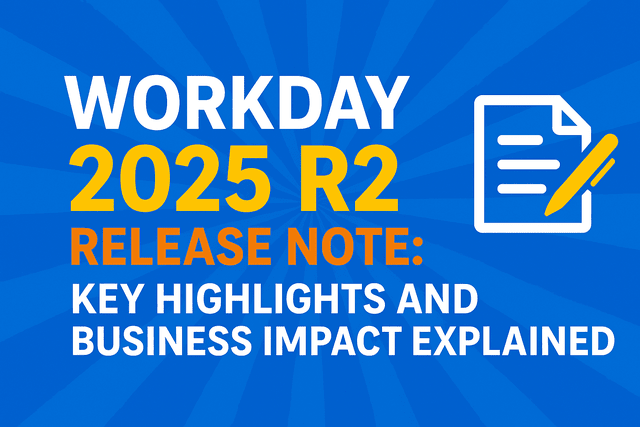
Workday 2025 R2 Release Note: Key Highlights and Business Impact Explained
The 2025 R2 Release presents significant improvements focused on simplified operations, increased insights, and operational fluidity. It introduces sophisticated functions on reporting, planning, security, and analytics all aimed at honing business processes. The enhancements reflect contemporary business requirements of efficiency and clarity. The sections that follow identify five areas of development and unpack their practical value.
Table of Content
Enhanced Reporting and Analytics
Workday 2025 R2 Release note talks about sophisticated reporting capabilities designed to provide more actionable information and make it easier to access. New features involve data visualization, dashboard integration, and filtering.
They enable users to efficiently analyze complex data and extract valuable trends without requiring a lot of manual configurations. Attention to clarity and responsiveness in report creation also helps organizations align strategic decisions with operational realities more effectively, decreasing the latency of insight creation and facilitating a more responsive reaction to newly emerging information.
Smarter Planning and Scenario Management
Enhancements in planning capability indicate an emphasis on agility and cooperation. Scenario management has been updated to allow more flexible what-if modeling and easier version control. Improved sharing capabilities allow teams to collaborate on planning data and remain within the security boundaries.
The effect is a more flexible budgeting and forecasting process, with several versions that can be compared and refined on the fly. This eases dynamic decision-making under uncertainty making it easier to align across departments and make corrections quicker as the situation changes.
Streamlined Security and Access Controls
Access controls and security have been raised to favor both convenience and governance. The release increases permissions control, allowing more granular control over exposure of data. Audit trails and more intuitive role assignments add visibility and accountability.
Administrators are now able to customize access to certain functions without overemphasizing permissions and lowering risk. Its enhanced security stance instills confidence in compliance-sensitive settings with context-aware access that is more natural to users. The net effect is a system that is more applicable to regulated industries and complicated organizational structures.
Improved Workflow Automation
Automation enhancements are aimed at minimizing manual labor and maximizing consistency. The release provides improved orchestration capabilities to automate repetitive activities like synchronization of data, approval routing, and notifications.
There has been an increase in the amount of workflow templates to support more workflow scenarios that can be easily deployed without being custom configured. These improvements diminish operating friction and liberate teams to focus on more valuable strategic efforts. The streamlined automation system facilitates a standardized workflow and increases productivity of the entire administrative and HR processes.
Optimized Performance and User Experience
Improvements in performance facilitate ease of navigation, quick load times, and increased responsiveness. The updates optimize processing and user interface, making reports render faster and interactions smoother. The transition between pages and searches becomes smoother, reducing friction on the user.
Such enhancements minimize cognitive overload and increase adoption through a more natural, trustworthy environment. As performance meets the expectations of the user, the training burden is reduced and engagement increases. The outcome is a more satisfying and efficient end-user experience which will improve overall productivity.
Conclusion
The 2025 R2 Release provides focused updates in reporting, planning, security, automation, and user experience, which is in line with the current requirements of the modern enterprise in responsiveness, collaboration, and governance. These updates facilitate more intelligent and efficient operations and eliminate friction and boost insight-driven actions.
They can assist organizations in scaling and adapting with certainty in an ever-changing business environment, particularly when integrating enterprise Workday testing with Opkey, where automated, no-code verification is applied, accelerating updates and reducing release-related hazards.
The test discovery and continuous testing capabilities of Opkey, enabled using AI, help validate even complicated workflows without manual intervention, and thus greatly reduce the time taken to complete the testing cycle. It also integrates seamlessly with Workday, which enables teams to identify and fix problems before they occur, making deployments smoother and making the system more reliable.


